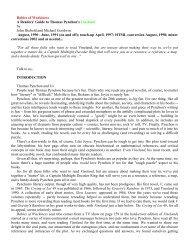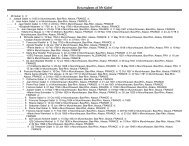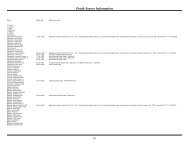CRC Handbook of Chemistry and Physics, 86th Edition
CRC Handbook of Chemistry and Physics, 86th Edition
CRC Handbook of Chemistry and Physics, 86th Edition
Create successful ePaper yourself
Turn your PDF publications into a flip-book with our unique Google optimized e-Paper software.
The Elements 4-25<br />
forms <strong>of</strong> solid nitrogen exist, with the transition from the α to<br />
the β form taking place at –237°C. When nitrogen is heated, it<br />
combines directly with magnesium, lithium, or calcium; when<br />
mixed with oxygen <strong>and</strong> subjected to electric sparks, it forms<br />
first nitric oxide (NO) <strong>and</strong> then the dioxide (NO 2 ); when heated<br />
under pressure with a catalyst with hydrogen, ammonia is<br />
formed (Haber process). The ammonia thus formed is <strong>of</strong> the<br />
utmost importance as it is used in fertilizers, <strong>and</strong> it can be oxidized<br />
to nitric acid (Ostwald process). The ammonia industryis<br />
the largest consumer <strong>of</strong> nitrogen. Large amounts <strong>of</strong> gas<br />
are also used by the electronics industry, which uses the gas as<br />
a blanketing medium during production <strong>of</strong> such components<br />
as transistors, diodes, etc. Large quantities <strong>of</strong> nitrogen are<br />
used in annealing stainless steel <strong>and</strong> other steel mill products.<br />
The drug industry also uses large quantities. Nitrogen is used<br />
as a refrigerant both for the immersion freezing <strong>of</strong> food products<br />
<strong>and</strong> for transportation <strong>of</strong> foods. Liquid nitrogen is also<br />
used in missile work as a purge for components, insulators<br />
for space chambers, etc., <strong>and</strong> by the oil industry to build up<br />
great pressures in wells to force crude oil upward. Sodium <strong>and</strong><br />
potassium nitrates are formed by the decomposition <strong>of</strong> organic<br />
matter with compounds <strong>of</strong> the metals present. In certain<br />
dry areas <strong>of</strong> the world these saltpeters are found in quantity.<br />
Ammonia, nitric acid, the nitrates, the five oxides (N 2 O, NO,<br />
N 2 O 3 , NO 2 , <strong>and</strong> N 2 O 5 ), TNT, the cyanides, etc. are but a few<br />
<strong>of</strong> the important compounds. Nitrogen gas prices vary from<br />
2¢ to $2.75 per 100 ft 3 (2.83 cu. meters), depending on purity,<br />
etc. Production <strong>of</strong> elemental nitrogen in the U.S. is more than<br />
9 million short tons per year. Natural nitrogen contains two<br />
isotopes, 14 N <strong>and</strong> 15 N. Ten other isotopes are known.<br />
Nobelium — (Alfred Nobel [1833–1896], inventor <strong>of</strong> dynamite),<br />
No; at. wt. [259]; at. no. 102; valence +2, +3. Nobelium was<br />
unambiguously discovered <strong>and</strong> identified in April 1958 at<br />
Berkeley by A. Ghiorso, T. Sikkel<strong>and</strong>, J. R. Walton, <strong>and</strong> G. T.<br />
Seaborg, who used a new double-recoil technique. A heavy-ion<br />
linear accelerator (HILAC) was used to bombard a thin target<br />
<strong>of</strong> curium (95% 244 Cm <strong>and</strong> 4.5% 246 Cm) with 12 C ions to produce<br />
102 254 according to the 246 Cm ( 12 C, 4n) reaction. Earlier in<br />
1957 workers <strong>of</strong> the U.S., Britain, <strong>and</strong> Sweden announced the<br />
discovery <strong>of</strong> an isotope <strong>of</strong> Element 102 with a 10-min half-life<br />
at 8.5 MeV, as a result <strong>of</strong> bombarding 244 Cm with 13 C nuclei.<br />
On the basis <strong>of</strong> this experiment the name nobelium was assigned<br />
<strong>and</strong> accepted by the Commission on Atomic Weights<br />
<strong>of</strong> the International Union <strong>of</strong> Pure <strong>and</strong> Applied <strong>Chemistry</strong>.<br />
The acceptance <strong>of</strong> the name was premature, for both Russian<br />
<strong>and</strong> American efforts now completely rule out the possibility<br />
<strong>of</strong> any isotope <strong>of</strong> Element 102 having a half-life <strong>of</strong> 10 min in<br />
the vicinity <strong>of</strong> 8.5 MeV. Early work in 1957 on the search for<br />
this element, in Russia at the Kurchatov Institute, was marred<br />
by the assignment <strong>of</strong> 8.9 ± 0.4 MeV alpha radiation with a halflife<br />
<strong>of</strong> 2 to 40 sec, which was too indefinite to support claim<br />
to discovery. Confirmatory experiments at Berkeley in 1966<br />
have shown the existence <strong>of</strong> 254 102 with a 55-s half-life, 252 102<br />
with a 2.3-s half-life, <strong>and</strong> 257 102 with a 25-s half-life. Twelve<br />
isotopes are now recognized, one <strong>of</strong> which — 255 102 — has a<br />
half-life <strong>of</strong> 3.1 min. In view <strong>of</strong> the discover’s traditional right<br />
to name an element, the Berkeley group, in 1967, suggested<br />
that the hastily given name nobelium, along with the symbol<br />
No, be retained.<br />
Osmium — (Gr. osme, a smell), Os; at. wt. 190.23(3); at. no. 76;<br />
m.p. 3033°C; b.p. 5012°C; sp. gr. 22.57; valence 0 to +8, more<br />
usually +3, +4, +6, <strong>and</strong> +8. Discovered in 1803 by Tennant in<br />
the residue left when crude platinum is dissolved by aqua regia.<br />
Osmium occurs in iridosmine <strong>and</strong> in platinum-bearing<br />
river s<strong>and</strong>s <strong>of</strong> the Urals, North America, <strong>and</strong> South America.<br />
It is also found in the nickel-bearing ores <strong>of</strong> Sudbury, Ontario,<br />
region along with other platinum metals. While the quantity<br />
<strong>of</strong> platinum metals in these ores is very small, the large tonnages<br />
<strong>of</strong> nickel ores processed make commercial recovery<br />
possible. The metal is lustrous, bluish white, extremely hard,<br />
<strong>and</strong> brittle even at high temperatures. It has the highest melting<br />
point <strong>and</strong> the lowest vapor pressure <strong>of</strong> the platinum group.<br />
The metal is very difficult to fabricate, but the powder can<br />
be sintered in a hydrogen atmosphere at a temperature <strong>of</strong><br />
2000°C. The solid metal is not affected by air at room temperature,<br />
but the powdered or spongy metal slowly gives <strong>of</strong>f<br />
osmium tetroxide, which is a powerful oxidizing agent <strong>and</strong> has<br />
a strong smell. The tetroxide is highly toxic, <strong>and</strong> boils at 130°C<br />
(760 mm). Concentrations in air as low as 10 –7 g/m 3 can cause<br />
lung congestion, skin damage, or eye damage. The tetroxide<br />
has been used to detect fingerprints <strong>and</strong> to stain fatty tissue<br />
for microscope slides. The metal is almost entirely used to<br />
produce very hard alloys, with other metals <strong>of</strong> the platinum<br />
group, for fountain pen tips, instrument pivots, phonograph<br />
needles, <strong>and</strong> electrical contacts. The price <strong>of</strong> 99.9% pure osmium<br />
powder — the form usually supplied commercially — is<br />
about $100/g, depending on quantity <strong>and</strong> supplier. Natural<br />
osmium contains seven isotopes, one <strong>of</strong> which, 186 Os, is radioactive<br />
with a very long half-life. Thirty four other isotopes<br />
<strong>and</strong> isomers are known, all <strong>of</strong> which are radioactive.The measured<br />
densities <strong>of</strong> iridium <strong>and</strong> osmium seem to indicate that<br />
osmium is slightly more dense than iridium, so osmium has<br />
generally been credited with being the heaviest known element.<br />
Calculations <strong>of</strong> the density from the space lattice, which<br />
may be more reliable for these elements than actual measurements,<br />
however, give a density <strong>of</strong> 22.65 for iridium compared<br />
to 22.61 for osmium. At present, therefore, we know either<br />
iridium or osmium is the heaviest element, but the data do not<br />
allow selection between the two.<br />
Oxygen — (Gr. oxys, sharp, acid, <strong>and</strong> genes, forming; acid former),<br />
O; at. wt. 15.9994(3); at. no. 8; t.p. –218.79°C; t c –118.56°C; valence<br />
2. For many centuries, workers occasionally realized air<br />
was composed <strong>of</strong> more than one component. The behavior <strong>of</strong><br />
oxygen <strong>and</strong> nitrogen as components <strong>of</strong> air led to the advancement<br />
<strong>of</strong> the phlogiston theory <strong>of</strong> combustion, which captured<br />
the minds <strong>of</strong> chemists for a century. Oxygen was prepared by<br />
several workers, including Bayen <strong>and</strong> Borch, but they did not<br />
know how to collect it, did not study its properties, <strong>and</strong> did not<br />
recognize it as an elementary substance. Priestley is generally<br />
credited with its discovery, although Scheele also discovered<br />
it independently. Oxygen is the third most abundant element<br />
found in the sun, <strong>and</strong> it plays a part in the carbon-nitrogen<br />
cycle, one process thought to give the sun <strong>and</strong> stars their energy.<br />
Oxygen under excited conditions is responsible for the<br />
bright red <strong>and</strong> yellow-green colors <strong>of</strong> the aurora. Oxygen, as<br />
a gaseous element, forms 21% <strong>of</strong> the atmosphere by volume<br />
from which it can be obtained by liquefaction <strong>and</strong> fractional<br />
distillation. The atmosphere <strong>of</strong> Mars contains about 0.15%<br />
oxygen. The element <strong>and</strong> its compounds make up 49.2%, by<br />
weight, <strong>of</strong> the earth’s crust. About two thirds <strong>of</strong> the human<br />
body <strong>and</strong> nine tenths <strong>of</strong> water is oxygen. In the laboratory it<br />
can be prepared by the electrolysis <strong>of</strong> water or by heating potassium<br />
chlorate with manganese dioxide as a catalyst. The gas<br />
is colorless, odorless, <strong>and</strong> tasteless. The liquid <strong>and</strong> solid forms<br />
are a pale blue color <strong>and</strong> are strongly paramagnetic. Ozone







